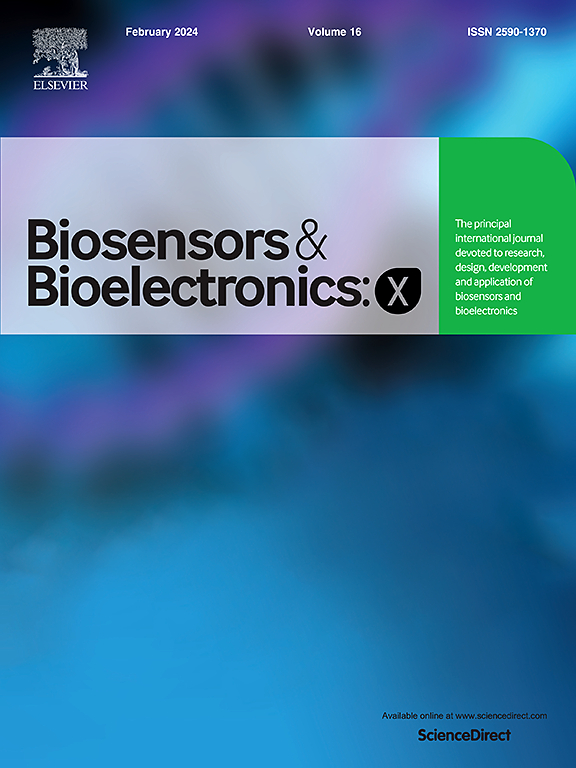Design and analysis of a magneto-resistance-based device to mitigate risks from high magnetic field exposure
IF 10.61
Q3 Biochemistry, Genetics and Molecular Biology
引用次数: 0
Abstract
The motivation is to develop a device for pacemaker-implanted patients that would automatically alert them in an intense magnetic field. Moreover, the employees working near any strong magnetic environment would benefit by avoiding high exposure. This research delves into a comprehensive process for the implementation and characterization of such a wearable based on the magnetoresistance effect, which is a function of the magnetic field. The program executes on the Arduino IDE platform. Samples are taken for varying magnetic flux density along each axis, for changes in distance of 2.5 mm. The calculations take place accordingly and provide outputs in microtesla units. Subsequently, the device is analyzed by plotting the responses, and it also helps to understand the working procedure. For a certain axis, the magnetic field is generally stronger than others. The goal is to determine the highest absolute value at any instance, including the Earth's geomagnetic field of 22–67 μT. Regulatory standards are followed to divide the magnetic flux density into four states: power saver (below 150 μT), safe (150–500 μT), unsafe (500–750 μT), and danger (over 750 μT). These values consist of ±20 μT error, which is quite insignificant. Depending on the state, the novel device generates different warning signals to mitigate risk from magnetic fields. From the error bar plot, it is realized that the percentage of error decreases while calculating higher magnetic flux. The errors could be reduced remarkably by ensuring better calibration and compensation techniques in the future.
设计和分析一种基于磁电阻的装置,以减轻高磁场暴露的风险
其动机是为植入心脏起搏器的患者开发一种装置,该装置可以在强磁场中自动提醒他们。此外,在任何强磁环境附近工作的员工都可以避免高暴露。本研究基于磁场的函数磁阻效应,对这种可穿戴设备的实现和表征进行了全面的研究。该程序在Arduino IDE平台上执行。沿着每条轴的不同磁通密度采集样品,距离变化为2.5 mm。计算相应地进行,并提供以微特斯拉为单位的输出。随后,通过绘制响应来分析设备,也有助于了解工作流程。对于某个轴,磁场通常比其他轴强。目标是确定在任何情况下的最高绝对值,包括22-67 μT的地球地磁场。根据法规标准,将磁通密度分为节能(低于150 μT)、安全(150 ~ 500 μT)、不安全(500 ~ 750 μT)和危险(超过750 μT)四种状态。这些值由±20 μT的误差组成,这是相当不显著的。根据不同的状态,这种新型装置会产生不同的警告信号,以减轻磁场带来的风险。从误差柱状图中可以看出,计算较高磁通时,误差百分比减小。通过确保未来更好的校准和补偿技术,可以显著减少误差。
本文章由计算机程序翻译,如有差异,请以英文原文为准。
求助全文
约1分钟内获得全文
求助全文
来源期刊

Biosensors and Bioelectronics: X
Biochemistry, Genetics and Molecular Biology-Biophysics
CiteScore
4.60
自引率
0.00%
发文量
166
审稿时长
54 days
期刊介绍:
Biosensors and Bioelectronics: X, an open-access companion journal of Biosensors and Bioelectronics, boasts a 2020 Impact Factor of 10.61 (Journal Citation Reports, Clarivate Analytics 2021). Offering authors the opportunity to share their innovative work freely and globally, Biosensors and Bioelectronics: X aims to be a timely and permanent source of information. The journal publishes original research papers, review articles, communications, editorial highlights, perspectives, opinions, and commentaries at the intersection of technological advancements and high-impact applications. Manuscripts submitted to Biosensors and Bioelectronics: X are assessed based on originality and innovation in technology development or applications, aligning with the journal's goal to cater to a broad audience interested in this dynamic field.
 求助内容:
求助内容: 应助结果提醒方式:
应助结果提醒方式:


